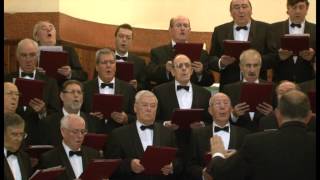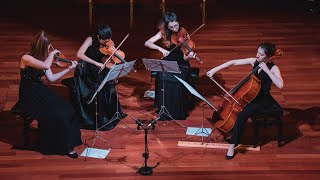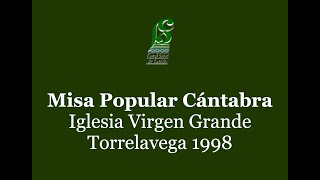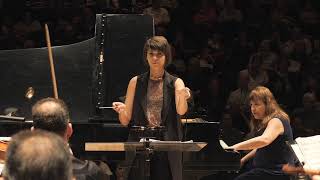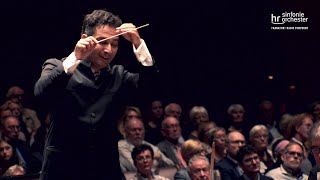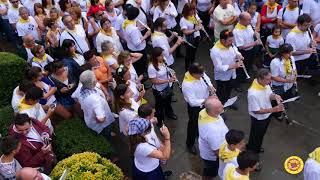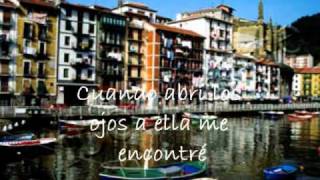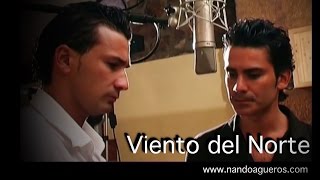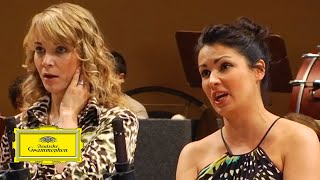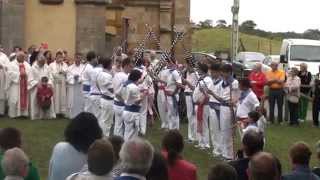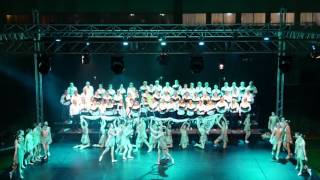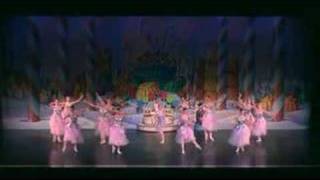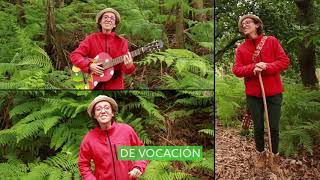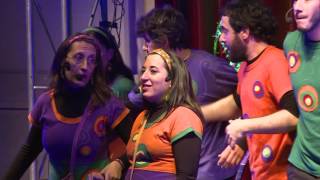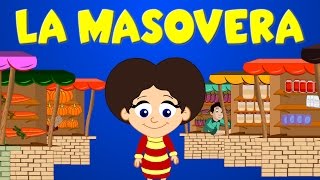On August 10th, Cantabria Day is celebrated.
The Patron Saint Festivities of the Biscayan towns of Ondarroa and Portugalete begin on August 14th.
On August 15, the Catholic Church celebrates the Feast of the Assumption of the Virgin Mary.
Recommended music videos for initiation to classical music
Cantabria Day , traditionally known as Mountain Day , is celebrated on the second Sunday in August in the town of Cabezón de la Sal and is a day of celebration of the customs, traditions and ethnographic values of the Community . During this time, thousands of people fill the streets of the town around the main activities, which revolve around folklore, rural sports, crafts and a market of typical products, a parade of floats and carts and the Tudanco cattle parade . All this is enlivened with typical Cantabrian music and dances through uninterrupted demonstrations by groups of dancers, picayos, tambourines, soloists, rabel players, pipers, bagpipers, troubadours, groups of young men, etc. The celebration has been declared a Festival of National Tourist Interest since 1972.
The montañesa song or montañesa tune is a lyrical folk musical genre developed in Cantabria , the main lyrical expression of the sung oral tradition of Cantabria along with the marzas, the jota montañesa (sung), the picayos, the aguinaldo and the romances . The Montañesa Song is mainly performed "a cappella", although sometimes a native instrument is used to accompany it, such as the pitu montañés and drum, the bagpipe , the tambourine or the castanets (tarrañuelas). Apart from being performed individually, it is also common to do so in collective formations through the "Corales" or the "Cantos de ronda".
Today we offer the song How beautiful is Santander, performed by Avelina Fernández .
The San Roque festivities have been celebrated in Portugalete (Bizkaia) for centuries. They begin on August 14 with the "chupinazo" (firecracker), the reading of the proclamation, and the " Tamborada Portugaluja" (Portugaluja Tamborrada) . On the 15th, the feast day of Our Lady , starting at eight in the morning, thousands of people accompanied by the Municipal Music Band march through the streets of the town singing the " Diana Portugaluja" (Portugaluja Diana). On the 16th , in the morning, there is the traditional procession from the Town Hall to the saint's hermitage; at 6 in the afternoon, there is the " Gran Descent" (Great Descent) , through the streets of the town to the Plaza del Solar , where the traditional "Dance of the Hour" will take place with the Municipal Band . On the 17th, the day of San Roquillo (the children's day). In the evening, the "Jarrilla" (a traditional candle) will be burned, bringing the patron saint festivities to a close.
Portugalete Maitia is the song, with lyrics by Iñaki Arenaza , composed by the director of the Municipal Band of Portugalete , Joseba Sáenz Ortuondo, to open the Tamborrada Portugaluja and which gives the title to the CD launched by the Municipal Music Band of Portugalete in commemoration of the centenary of its foundation; This CD was recorded with the collaboration of the main choral groups of the Villa . I (0´00´´) PORTUGALETE MAITIA (Santa María Choir, Friends of the Tamborrada and Municipal Band) .-. II (4´26´´) LA LLANISCA (Friends of the Tamborrada and BM) .-. III (7´19´´) VIRGEN DE LA GUÍA (Friends of the Tamborrada and BM) .-. IV (9´17´´) EL AIROSO (Friends of the Tamborrada and BM) .-. V (12´55´´) PORTUS GALEOTE (Barbis Taldea and BM) .-. VI (19´56´´) BOTECITO (Otxote Danok Bat and BM) .-. VII (23´30´´) TO PORTUGALETE (BM) .-. VIII (26'34'') AUPA PORTU! (Orfeón Jarrillero del Elai Alai and BM) .-. IX (30´45´´) THE BURIAL OF THE SARDINE (Coral Pleamar and BM) .-. X (34'43'') BUENAVISTA NEIGHBORHOOD (Coral Santa María and BM) .-. XI (40´12´´) EUSKAL HERRI POLITA GORA (Otxote Danok Bat and BM) .-. XII (43´00´´) PORTUGALETE NOBLE VILLA (Barbis Taldea and BM) .-. XIII (48´28´´) Diana Portugaluja (Portugal and BM choirs).
The Andra Mari Festival is the patron saint festival of Ondarroa (Bizkaia) in honor of the Virgin of the Antigua , the patron saint of the town. It begins on the night of August 14th-15th with the descent of Leokadi from the Church of Santa María and ends on the 17th, Arrantzale Eguna ("Fisherman's Day"), which is the main day along with the 15th, the day of the Virgin , and in between, on the 16th, San Roque , "day of the groups." All this with parades of txistularis, drumming, giants and big-heads, a marmitako competition, the kukaña, the goose competitions, bicycle races, soccer matches, dances, rock concerts, popular meals, brass bands, fireworks, mariachi concerts, and a special area for children's activities. In 2002, Gazte Eguna (Youth Day) was added to the calendar on August 13.
The Sestao Orfeón was founded in 1906 as the Parish Choir of the Church of Santa María, with Vitorio Epalza as its director. In 1944, it won first prize among choirs in Bilbao . In 1973, it recorded two albums in Madrid with Columbia Records; one with sacred songs and the other with Basque choral music. In 1975, as its presence was no longer required at liturgical functions, it became independent from the Parish. Since then, its performances have multiplied, appearing solo or with various artists and high-level professional groups. The Orfeón is composed solely of men, usually singing in four low voices.
Today they offer us Boga boga , a popular song that mentions the departure to sea of the arrantzales (sailors) of Ondarroa , arranged by Jesús Guridi .
Charles Gounod (1818-1893) was a French composer best known to the general public for his Ave Maria , which we offer today. He was born in Paris and received his first classes from his mother until he enrolled at the Conservatoire . He was a very prolific composer of both sacred and secular works; among them, his opera Faust deserves special mention. His influence on other French composers such as Bizet, Saint-Saëns and Jules Massenet is undeniable. Even Debussy himself declared him "necessary" in that his aesthetic represented a powerful counterweight to the overwhelming Wagnerian thrust for that generation of French people.
The Bach/Gounod Ave Maria is a composition on the Latin text Ave Maria originally published in 1853. The piece consists of a melody by Gounod , designed to be superimposed over the Prelude No. 1 in C major, BWV 846 , from Book I of J.S. Bach 's The Well-Tempered Clavier written 137 years earlier. Along with Schubert 's Ave Maria , the Bach-Gounod Ave Maria has become a fixture in weddings, funerals and celebrations of all kinds. There are many different arrangements for guitar, violin, string quartet, piano, cello, trombone ensemble , opera singers, choirs ... which have recorded and / or performed it in public hundreds of times during the 20th century .
Angela Gheorghiu (Adjud, Romania, September 7, 1965) is a Romanian lyric soprano. She excels in the Italian and French romantic and verismo repertoires, especially in operas by Puccini and Verdi , and is considered the best Violetta of the last twenty years, as well as one of the best representatives of the lyric strings of Mimì and Magda in her generation. Her range usually extends to a D in the sixth octave, although she has demonstrated that she can reach an E flat in Bellini's aria "Vien Diletto" . Her voice is powerful, sonorous, and her personal timbre distinguishes her internationally. Today she offers us Gounod 's Ave Maria .
Recommended classical music videos
Juan Crisóstomo de Arriaga (1806 - 1826), known by many as the Basque Mozart , was born in Bilbao . His father, Juan Simón , came from Errigoiti , a town near Gernika , where his mother, Maria Rosa , was from. His father, an organist from Berriatua , Bizkaia , moved to Bilbao to, as a good Errigotiarra, dedicate himself to business, with which he prospered and thus was able to promote Juan Crisóstomo 's educational development in Paris , where he died 10 days before his 20th birthday. The musical legacy, which has been preserved, consists of three string quartets, the octet Nada y mucho , written at the age of 11, the Overture No. 1 , the Symphony in D, several arias and cantatas as well as some motets and an opera, Los esclavos felices , written at the age of thirteen of which only the overture is preserved.
The String Quartets of Juan Crisóstomo de Arriaga are a collection of three quartets written for two violins, viola, and cello, composed in 1823, when the composer was only sixteen years old. The Three Quartets , structured in four movements, were the only work the composer would see published during his lifetime.
Today we present the String Quartet No. 1 in D minor : I (00:02) ALLEGRO .-. II (07:24) ADAGIO CON ESPRESSIONE .-. III (13:19) MENUETTO - ALLEGRO - TRIO MODERATO .-. IV (16:59) ADAGIO – ALLEGRETTO. The performance corresponds to the Óscar Esplá Quartet from Asisa made up of Raquel Areal Martínez (violin), Patricia Cordero Beltrán (violin), Raquel De Benito Forriol (viola) and Montserrat Egea (cello).
Nobel Sámano (1933-2019) is probably the most important contemporary composer of Cantabrian popular music. Born in Torrelavega ( Cantabria ), he began his piano studies as a child under the tutelage of his father; which later led him to complete them with composition and conducting. A life dedicated to music and to dignifying the folklore of Cantabria . Considered one of the most prominent figures in the musical creation of his land, he combined his facet as a composer with an entire career as a pianist, giving concerts in halls in Paris, Madrid and Barcelona , among other major cities. His work, as a composer, includes pieces for solo piano, songs with piano and choral music, as well as orchestral works such as the Fantasia on Cantabrian Themes . He died in his hometown of Torrelavega at the age of 85.
One of his best-known works is Misa Popular Cántabra , which we offer today and which premiered on February 8, 1997, at the Cathedral of Santander . This composition has been performed in the cathedrals of León and Santiago and in reference churches in Madrid, Barcelona, Pamplona and Cuenca , among other venues, as well as in numerous churches and auditoriums in Cantabria . The work, without faithfully following the liturgical text, does so in a rather sentimental, traditional, costumbrista and folkloric way. The score is considered one of the most important contributions to the popular polyphonic repertoire of religious style in Cantabria in the 20th century . ( Text extracted from the article by Lola Gallardo in the Diario Montañés ).
Today it is presented to us by the Laredo Choir , the Salvé de Laredo Choir , the Ronda Valle de Camargo Choir , the Luétiga Instrumental Group and the Ntra Sra de Covadonga Dance Group , all of them under the baton of maestro José Luis Ocejo .
Clara Wieck (1819-1896), better known as Clara Schumann , was a German pianist, composer and piano teacher. As a pianist, she was a leading figure in the 19th century and a key figure in the dissemination of the works of her husband Robert Schumann . She was born and raised in Leipzig into a musical family, where her mother was a famous singer and her father, a professional pianist and teacher of Clara , a child prodigy. She began to become known in Europe at the age of eleven; she married Robert Schumann and the couple had eight children. Together, they encouraged Johannes Brahms and maintained a close relationship with him. As a composer, she has left us a legacy of pieces for solo piano, a Piano Concerto , which we offer today, chamber music, orchestral works, 30 lieder and choral music.
Catalogue of the works of Clara Wieck . Her works are classified by their Opus number (from the Latin opus 'work'), a term used in music to catalogue the works of most composers. Since the 17th century , this form of cataloguing began to be used whenever a work was published, preceding the word Opus , or its abbreviation Op ., with the serial number of the work.
Piano Concerto in A minor , Op. 7. In January 1833, at the age of 13, Clara Wieck ( Clara Schumann after her marriage to Robert Schumann ) began composing a single-movement Konzertsatz which she orchestrated herself. In February 1834, her future husband Robert Schumann revised the orchestration, and the 14-year-old child prodigy performed it in several concerts. She then expanded the work by adding two more movements, using the Konzertsatz as the third movement, and re-orchestrating the entire work herself, completing it on 1 September 1835 (she was not yet 16) and premiering it in November 1835 with herself as soloist accompanied by the Leipzig Gewandhaus Orchestra conducted by Felix Mendelssohn .
Structure . I (0´02´´) ALLEGRO MAESTOSO .-. II (6'52'') ROMANCE. ANDANTE NON TROPPO CON GRAZIA (11´04´´) .-. III (11´02´´) FINALE: ALLEGRO NON TROPPO – ALLEGRO MOLTO. Today's version is offered to us by pianist Michal Tal accompanied by the Israel Camerata Jerusalem Oechstra conducted by teacher Keren Kagarlitsky.
( We reiterate our absolute condemnation of the genocide that the State of Israel is committing against the Palestinian People ).
George Gershwin (1898–1937) was an American composer, the son of Russian immigrants, appreciated for his ability to combine jazz with classical music . From a young age, he began writing his first songs, even premiering his first musical on Broadway with his brother Ira as lyricist, a company he would never abandon. From the age of twenty, he began to compose works intended for concert halls, with which he achieved renowned success. Aware of his formal deficiencies, he traveled to Paris to complete his training with Stravinsky , who, after asking him about the money he earned in a year, replied that he was the one who should take classes with Gershwin . Something similar happened with Ravel , as he told him: "Why do you want to be a second-rate Ravel when you can be a first-rate Gershwin ?"
An American in Paris is a symphonic classical work by George Gershwin, composed in 1928. It premiered on December 13, 1928, at Carnegie Hall in New York City under the baton of Walter Damrosch . Gershwin was of the opinion that: "...jazz is a very powerful element which is more in the blood and heart of every American than any other style of popular music. I believe it can be worked into serious symphonic works of permanent value." The work contains quotations from Ravel 's Piano Concerto of the same period. Furthermore, Gershwin said of his composition: "My purpose here is to portray the impressions of an American visiting Paris ; as he walks through the city, listens to various street noises, and absorbs the French atmosphere... The first part is developed in a typically French style, in the manner of Debussy or the Group of Six ." In addition to the usual instruments of a symphony orchestra, Gershwin occasionally used car horns; for the premiere, the composer brought taxi horns from Paris ; the piece also features instruments not often used in this context, such as the celesta and saxophones.
Today we present the version of the Frankfurt Radio Symphony Orchestra conducted by Colombian maestro Andrés Orozco-Estrada .
Recommended music videos for all tastes
The Diana Portugaluja with lyrics by Pedro Heredia and music by Marcelino Amenábar (first director of the Municipal Band of Portugalete ), is a fusion of the well-known diana castrense and the composition A la verbena también by maestro Amenábar . In the early hours of the morning of August 15, thousands of people gather in front of the Town Hall to carry out the Diana Portugaluja , whose objective is to wake up all the jarriller@s in order to invite them to the party. It is attended without any instrument since the one in charge of marking the sounds is the Municipal Music Band . After two hours walking through the streets of the Villa, you arrive at the Plaza de la Ranchería , where people taste the traditional garlic soup.
Nerea Sáenz Artetxe grew up surrounded by music. Her father and uncle formed the group Ondarruko Zintzoak in the 1970s, and there was always a song playing in the house; how could she not take over? With a wide variety of influences, from classical music, singer-songwriters, jazz, Brazilian, to pop , she created the bands Estación Norte and Marte Menguante . She released her album Estación Norte in 1999 with the EMI record label and has collaborated as a composer for the television series “ Compañeros” and for Cartoon Network .
The song Tierra , dedicated to Ondarroa, speaks to us of love and gratitude for our roots, for the land, for our family... With very local references such as those of Zubi Zahar , the Alameda , the sirens of the port... and with lines interpreted with emotion, this very personal song manages to connect with a global feeling of longing that captivates whoever listens to it; it also has a very careful production and a very folk flavor that introduces us body and soul to Ondarroa with the graphic report by Leire Larrinaga .
Nando Agüeros (Torrelavega, 1976) is a “popular song worker” who is triumphing in northern Spain . “Four years ago I closed the pub I owned in Torrelavega —it was called Peor para el sol , like Sabina ’s song—because business was going downhill and my musical career was on the rise.” In 2006, Nando composed the song Viento del Norte , which he released with his brother Sergio and which we offer today as a tribute to Cantabria . The song was an immediate hit and, in just a few years, has gained enormous popularity, even being proposed as the official anthem of the Community of Cantabria .
Jacques Offenbach (1819-1880) was a French cellist and composer of German origin who converted to Catholicism in order to marry the Catholic Herminia de Alcain . He began his musical studies with his father, a music teacher; at the age of 14 his family moved to Paris where he continued his studies with Cherubini . In 1855 he founded the Bouffes Parisiens theatre, where he staged his own works, which reflect the joie de vivre of his time. He also presented entertaining adaptations of other musical geniuses such as G. Rossini . His German ancestry earned him enemies after the Franco-Prussian War; enemies that he ironically reflected in his operettas. A leading exponent of French operetta (he wrote hundreds of them), his remains rest in the Montmartre Cemetery.
The Tales of Hoffmann is an opera with music by Jacques Offenbach and a French libretto by Jules Barbier , based on three stories by E. T. A. Hoffmann . It premiered at the Opéra-Comique in Paris on 10 February 1881 . It is an opera that responds to the composer's desire to enter the world of Grand Opera . A highly inspired work, it effectively combines fantastic, sentimental, supernatural, satirical and grotesque aspects and remains a standard in the world operatic repertoire even in the 21st century , but the aria that managed to transcend the traditional setting is by far the Barcarolle for soprano and mezzo, performed in Act III and offered today by two eminent artists such as the Russian soprano Ana Netrebko and the Latvian mezzo Elīna Garanča .
Recommended peculiar videos
Basque dances (in Basque, Euskal Dantzak ) are a very important part of Basque culture and a fundamental part of its folklore. Each historical territory, or province, has its own dances, and each town also has its own dance, which is customarily performed at its major festivals. Among the most notable dances are the pilgrimage or plaza dances , based on the dances held at pilgrimages and whose participation was popular and spontaneous. Sword dances , which have clear parallels with European dances of the same type, are performed at the end of a festival, the end of one cycle, and the beginning of another.
Today we present a small interlude of these dances prepared and performed by the excellent and much-missed dantzari and choreographer Luis Exaburu (Latxanbre) with his formidable group Txanpa.
The Dance of the Spears is one of the most deeply rooted examples of Cantabrian folklore in the region, originating in the 16th century . It is a dance celebrated in honour of the patron saint of Ruiloba , the Virgin of Los Remedios , on her feast day, July 2nd. Only men participate in the dance, one of whom stands out, the pelotero , who, armed with a baton, leads the group in the centre, while the rest perform a dance using long sticks, the spears, following the orders of the rabonero or zaguero , who indicates the variations of the dance using castanets. The dance we offer today has been declared by the Government of Cantabria , along with eight other Cantabrian dances, as they are dances that form part of the cultural heritage of the Autonomous Community .
Portus Galeote . This song, with lyrics by Juanjo Tellaetxe and music originally written by Txema Lorente , director of Barbis Taldea , and arranged for band and choir by the band's director, Joseba Sáenz Ortuondo , is the result of a collaboration between the Municipal Band and various popular associations. In the video we are presenting today, the staging is enriched with choreography by Pilar Agirregomezkorta and performed by her Classical Ballet Academy . Jabier Ituarte Aulestia , the current head of the Portugalete Municipal Band , is conducting.
Pyotr Tchaikovsky (1840-1893) was a Russian composer who graduated from the St. Petersburg Conservatory and wrote works in various genres, although his greatest success was with his ballets. In 1859, he obtained a position as a civil servant in the Ministry of Justice , which he abandoned after three years to devote himself solely to music. His personal life was plagued by continuous crises following the death of his mother and his repressed homosexuality, which forced him into a marriage that only lasted a few months. He wrote more than 150 compositions, including piano works, quartets, suites, symphonies, concertos, chorales, cantatas, operas, and ballets. He died at the age of 53 and is considered one of the greatest composers in history.
The waltz (from the German Walzer , a term derived from the German verb walzen, 'to turn, to roll') is an elegant ballroom dance, documented in its definitive form since the late 18th century . It is the evolution of an ancient dance from the 12th century , originating in Tyrol (Austria) and southern Germany . The waltz gained its status as a noble dance in Vienna during the 1760s, quickly spreading to other countries. Some authors believe that the waltz originated from the volte or volta, a 3-beat dance practiced during the 16th century . The word waltz was born in the 18th century , when this dance was introduced into opera and ballet. Its most significant characteristic is that its time signatures are in 3/4 time.
Today we offer the choreography of the Waltz of the Flowers from Tchaikovsky 's Nutcracker Ballet.
Recommended music videos for children
Various Wikipedia articles have been used to write these texts.
The texts of Videomusicalis are written in Basque, Spanish and English.







